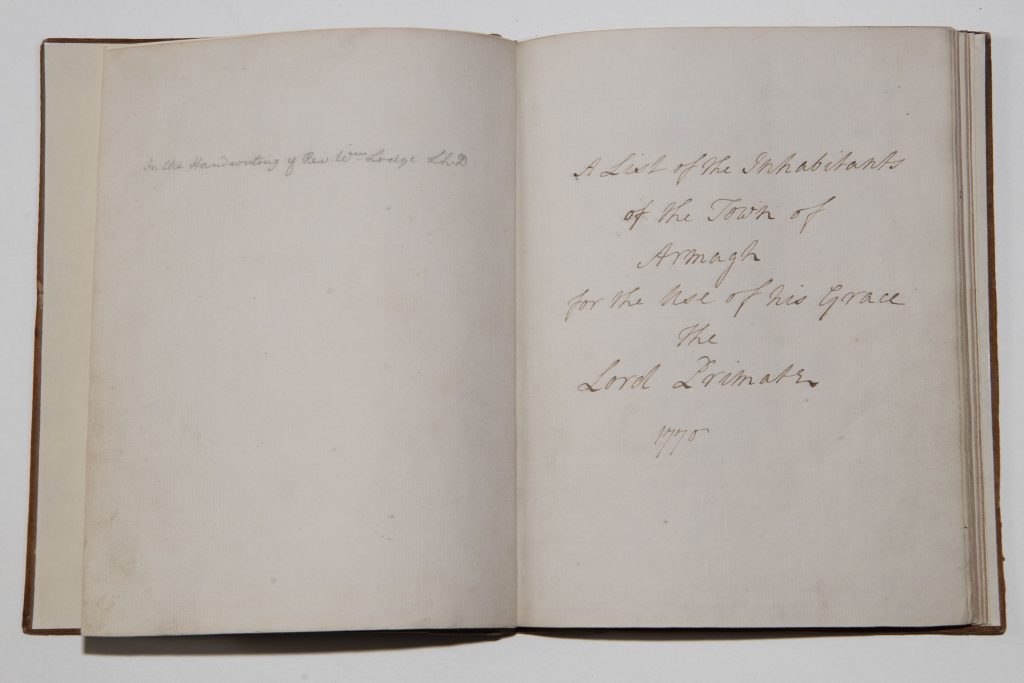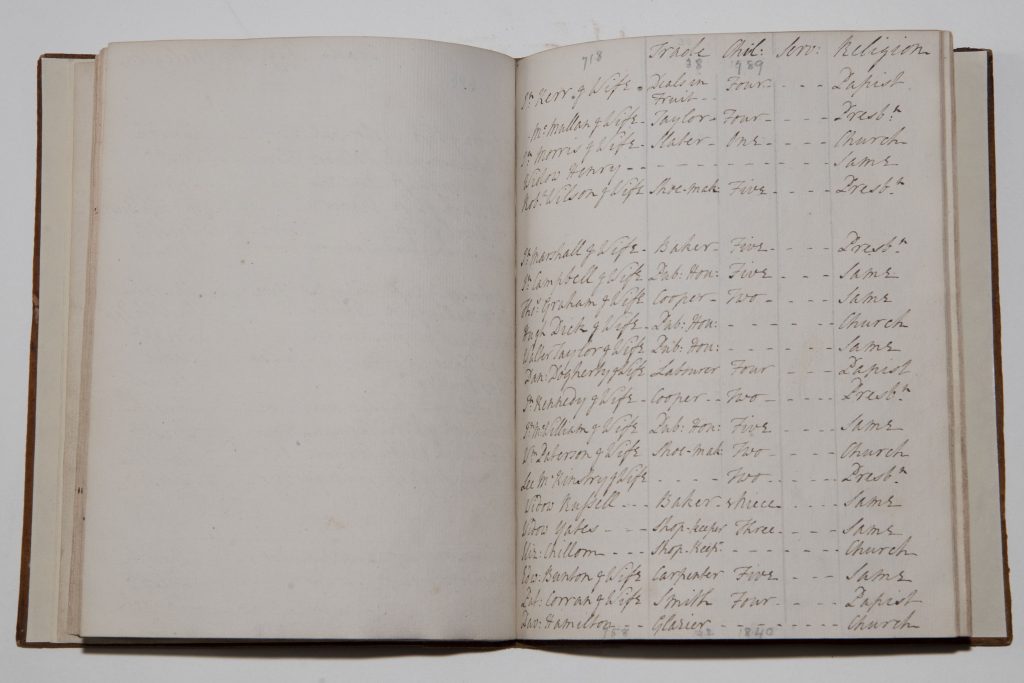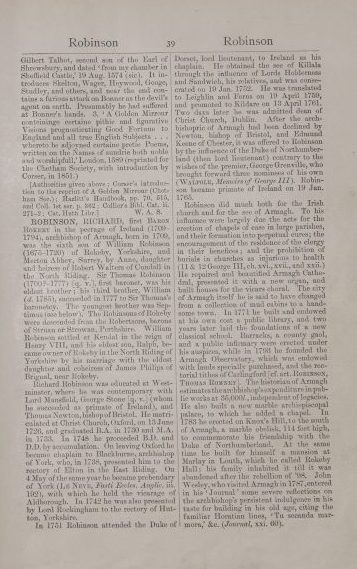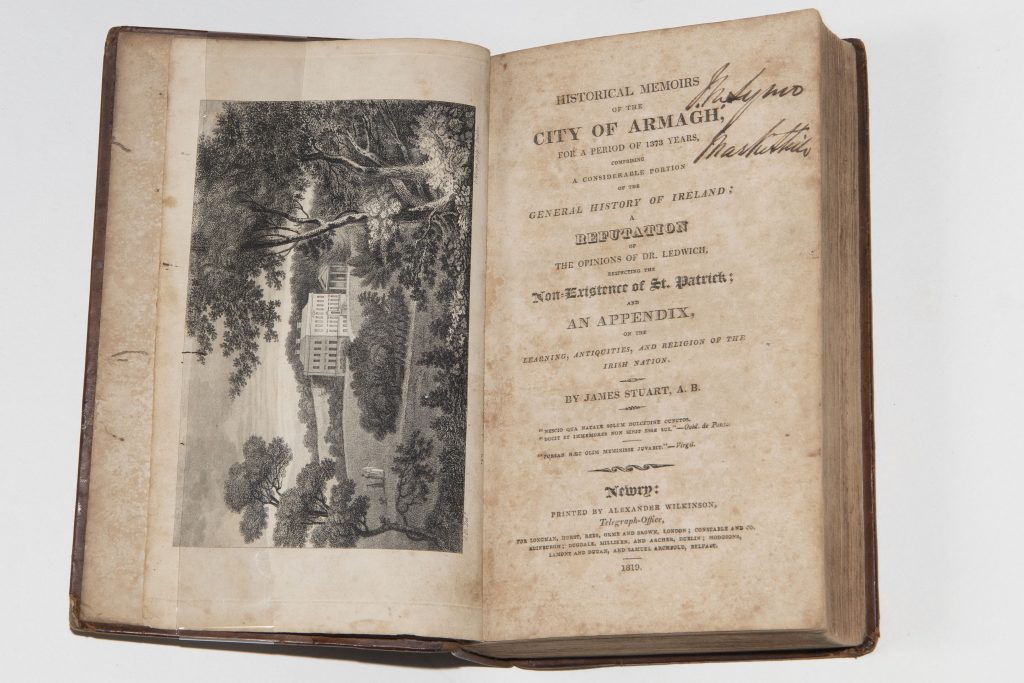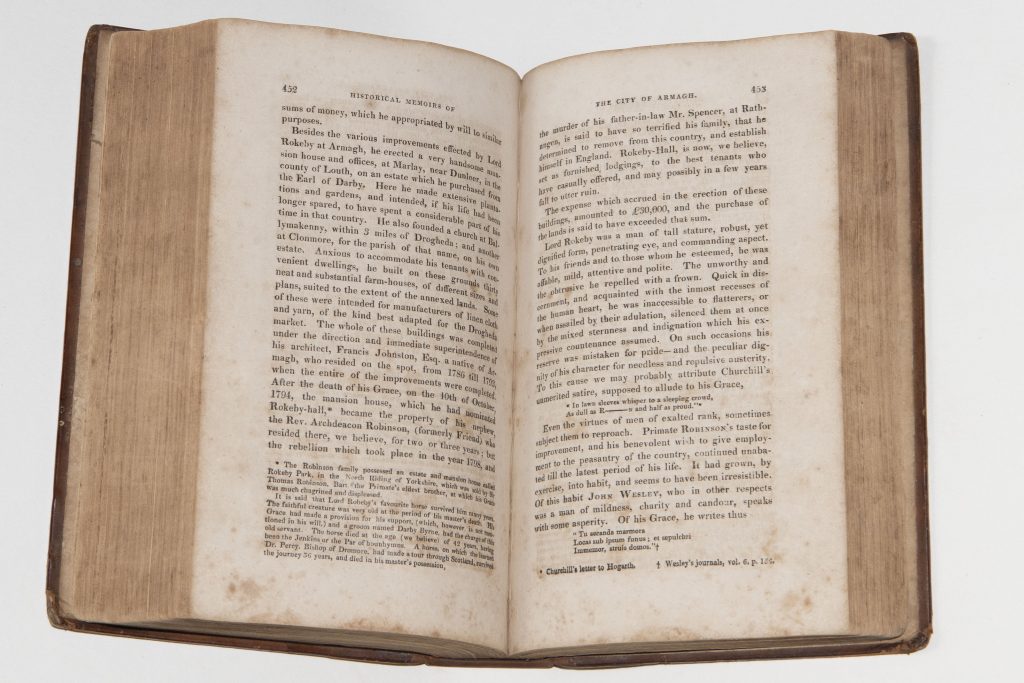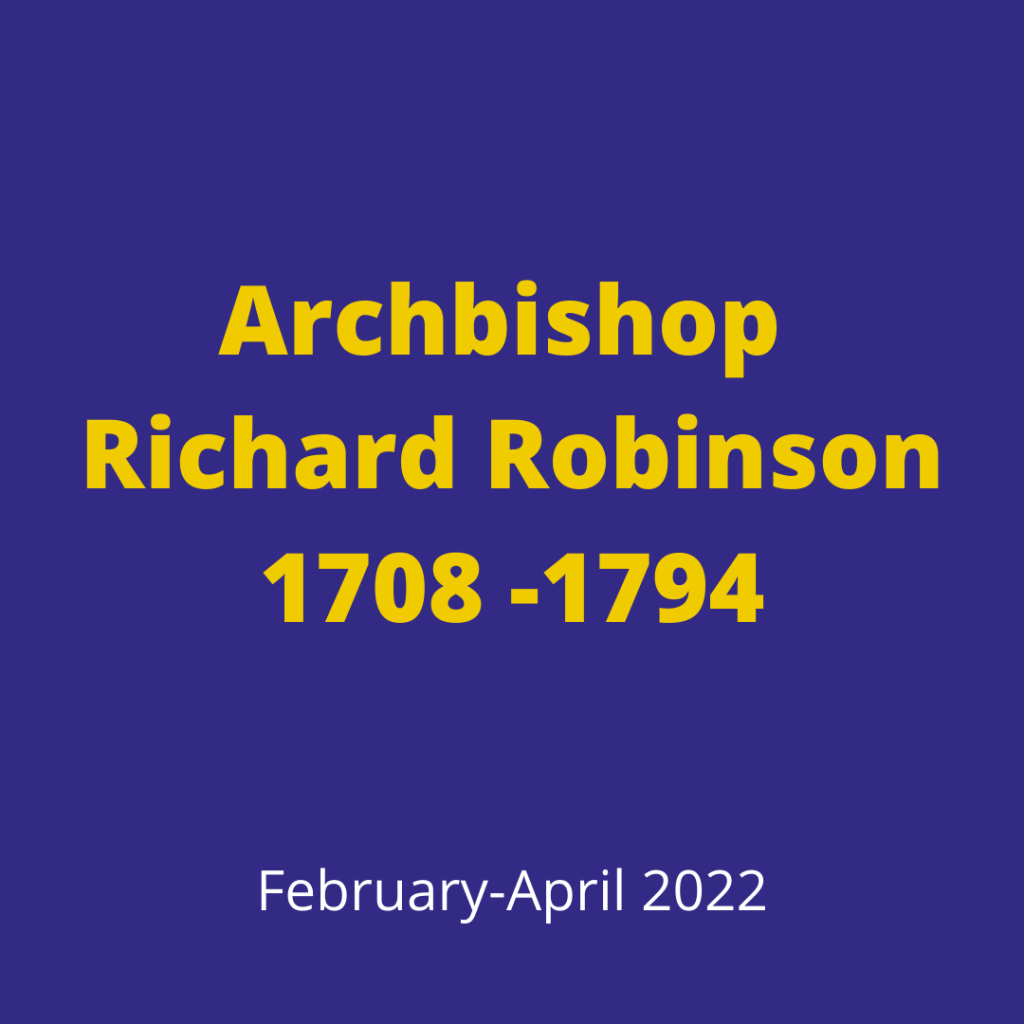
Archbishop Richard Robinson is the founder of Armagh Robinson Library.
In this exhibition we will shed some light on Robinson’s life and his contributions to Armagh.
Richard Robinson
Richard Robinson was baptised in St Mary’s Parish Church, Merton, Surrey on 13 July 1708. His actual birth date is not known. He was the sixth of nine children, seven boys and two girls, born to William Robinson and Anne Walters. Two of his brothers died before reaching adulthood.
Robinson was educated at Westminster School, London and then at Christ Church, Oxford.
His eldest brother, Thomas, inherited the title of Baronet of Rokeby in the English peerage, as well as the family’s estate in Rokeby, Yorkshire.
As often happened in large wealthy families, younger sons followed careers in the military or in the church. With the Robinson family, one brother, Henry, served in the army and Richard was ordained into the Anglican Church in the late 1730s.
Click on the images to see a full size version
Richard Robinson first came to Ireland in 1751, as chaplain to the Lord Lieutenant, the Earl of Dorset.
He was promoted within the Church of Ireland and became the Bishop of Killala from 1752 to 1759.
Subsequently he served as the Bishop of Ferns and Leighlin from 1759 to 1761, and the Bishop of Kildare from 1761 to 1765.He was appointed Archbishop of Armagh and the Primate of All Ireland in 1765, which he remained until his death in 1794.
List of the Inhabitants of the Town of Armagh for the Use of His Grace, the Lord Primate. William Lodge 1770 P002384481
Five years after his installation as Archbishop of Armagh, Robinson asked the Revd William Lodge to compile a list of all the inhabitants of Armagh. This list is now commonly known as the Census of the City of Armagh for 1770 and is held in the Library’s collection.
A particular page shows the citizens who lived in Scotch Street, including a carpenter, smith and glazier. From 1770 onwards, Robinson initiated eleven new building works and one renovation project in Armagh. We cannot help but wonder if the census proved helpful in finding Armagh citizens trained and experienced in the building trade!
An Act for Settling and Preserving a Publick Library in the City of Armagh Forever, and for Enabling the Archbishop of Armagh to appropriate Parts of a Piece of Waste Ground Contiguous to the Said City, to Certain Uses, for the Benefit of the Inhabitants thereof, and to Make Long Leases of the Remainder David Hay Dublin 1773 P001176869
The third building project initiated by Robinson was the Library. It was built in 1771 and established by Act of Parliament in 1773.
It was established as a Publick Library, and the Library remained known as ‘Armagh Public Library’ until 2017. In that year the Library was rebranded Armagh Robinson Library, in honour of its founder.
Dictionary of National Biography, Vol XLIX Sidney Lee, Leslie Stephen (editors) 1901 P001136492
In 1777, Robinson was created the first Baron Rokeby of Armagh in the Irish Peerage.
It was unlikely that he would also inherit the title of Baronet of Rokeby (created 1730). That title was passed on to his older brothers in turn, and he was son number six.
In 1785, however, he did receive the Baronetcy, when his last surviving brother, William, died. It must have been bitter-sweet to be handed the Baronetcy, as it seems that Richard and William were very close.
A print of William, which is part of Robinson’s print collection, is on display on the exhibition boards near the main entrance of the Long Room.
Commemorative medal for the opening of the Armagh Public Library in 1771 John Kirk, Manufacturer (1724 - 1778); Isaac Gosset, Artist 1771 2020.1 Purchased with support from the NI Museums Council and Esmé Mitchell Trust.
This silver medal was commissioned to commemorate the opening of the Library in 1771. It was designed by Isaac Gosset and manufactured by John Kirk.
The bust of Archbishop Richard Robinson is displayed on the obverse and the original facade of the Library with its three bay windows on the reverse.
The inscription indicates that it must have been manufactured in or after 1777, as it refers to Robinson as Baron Rokeby of Armagh:
RICH : HIBERN : PRIMAS . BARO : ROKEBY . DE . ARMAGH. GOSSET M. KIRK
Bookplate in A Short View of the Families of the present English Nobility; their Marriages, Issue, and immediate Ancestors; … Nathaniel Salmon London : William Owen, 1758 P001127280
Richard Robinson did not only pay for the building of the Library, he also donated over 8,000 books. These covered theology, philosophy, classical and modern literature, travels, history, medicine and law, all of which became the foundation of the Library.
Robinson used two different bookplates to mark his books:
- Robinson family arms and
- Diocese of Armagh arms,
- Robinson family arms, Diocese of Armagh arms, and archiepiscopal mitre and ribbons.
It is unclear when, or why, the change was made: Robinson had no prior affiliation with the Armagh Diocese before his appointment at Archbishop.
The Mystery and Method of His Majesty's Happy Restauration Laid Open to Publick View. … John Price London : James Vade, 1680 P001127264
This work is unusual as it contains Richard Robinson’s bookplate, his father’s inscription, as well as his older brother’s, Thomas Robinson, bookplate.
In most of the works previously owned by Thomas, Richard pasted his own bookplate over Thomas’!
Archbishop Robinson required all his papers to be burned after his death. There are no personal records left of his life in this Library
However, it holds some examples of his contemporaries’ views of his character.
Memoirs of Richard Cumberland: written by himself: containing an account of his life and writing, interspersed with anecdotes and characters of several of the most distinguished persons of his time, with whom he has intercourse and connexion. Richard Cumberland London : Lackington, Allen & Co, 1806 P001207594
Bishop Denison Cumberland and his son Richard were good friends of Robinson. Although Richard Cumberland was a much younger man, he knew Robinson well and would stay with him for several weeks in his Palace in Armagh. He mentions Robinson in his memoirs, as
Splendid, liberal, lofty, publicly ambitious of great deeds, and privately capable of good ones, there was an exterior, that to the stranger did not always hold out an encouraging aspect, but to him that stept within that barrier all was mildness, suavity, benevolence.
Memoirs of the City of Armagh, for a period of 1,373 years, comprising a considerable portion of the general history of Ireland, ... James Stuart Newry : Alexander Wilkinson, 1819 P000100346
Armagh-born James Stuart was a journalist and historian who attended the Royal School in Armagh. This would have been the new school building of 1774, which was part of Robinson’s plans to establish a university. Stuart would also have witnessed all the building work in Armagh as Robinson’s ideas for the City were carried out.
Stuart describes Robinson as:
… a man of tall stature, robust, yet dignified form, penetrating eye, and commanding aspect. To his friends and to those whom he esteemed, he was affable, mild, attentive and polite. The unworthy and the obtrusive he repelled with a frown. …
Primate Robinson’s taste for improvement, and his benevolent wish to give employment to the peasantry of the country, continued unabated till the latest period of his life.
The Gentleman’s Magazine: and Historical Chronicle. For the Year MDCCXCIV, Volume LXIV Part the Second Obituary of remarkable Persons; with Biographical Anecdotes 1794 P001208760
In 1765 Richard Robinson was appointed Archbishop of Armagh and Primate of Ireland, aged 57. He died on 10 October 1794 at the age of 86 in Clifton, Bristol and is buried in the Crypt of Armagh Cathedral.
His Last Will and Testament, of which the Library has a modern typescript copy, refers to the Library as follows:
His Last Will and Testament, of which the Library has a modern typescript copy, refers to the Library as follows:
…I further give and bequeath to the Governors of the said Library all my books that are at present deposited in the Library and One Copy of all Books in my possession at the time of my death in Ireland or England and which my Executors shall judge proper books for such a Library and of which there are no duplicates among those I shall have deposited where in my lifetime, different Editions of the same Book are not to be considered as Duplicates. Also I give to the said Governors all my medals coins Sculptures Prints Books of Prints. …
Archbishop Richard Robinson’s legacy continues to this day. During his time as Archbishop, the buildings below were improved or established, due to his vision and plans for the City of Armagh.
We leave it to you to decide if Robinson deserves a further, unofficial title: that of Builder of Armagh.
- Armagh Palace (1770) (now the ABC Council Offices)
- The Palace Farm (circa 1770)
- Armagh Robinson Library (1771)
- Diocesan Registry (1772) (now No 5 Vicars’ Hill)
- The Mall as a public park (1773)
- Military Barracks (1773)
- Armagh County Infirmary (1774)
- Royal School Armagh (1774) (new building)
- Nos 7 – 11 Vicar’s Hill (1776 – 1794)
- Armagh Gaol (1780-1852)
- The Primate’s Chapel (1781 – 1786)
- Armagh Observatory (1789-1793)
- St Patrick’s Cathedral, Armagh (alterations)


